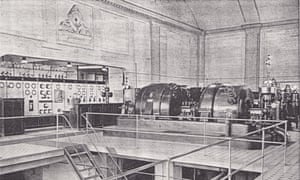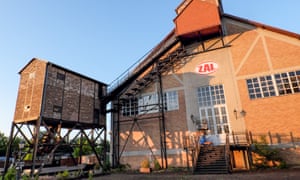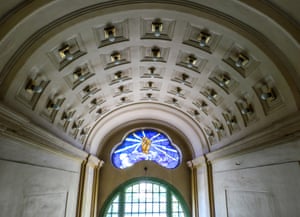E-Werk Luckenwalde will offer workshops and studio space for artists squeezed out of Berlin
A stained glass window over E-Werk’s main entrance. Photograph: Photo courtesy of Performance Electrics gGmbH
When the Luckenwalde coal power plant in east Germany closed down soon after the collapse of communism, the locals were both relieved and concerned. “Finally people could hang out their laundry without it getting covered in soot,” said Bernd Schmidl, one of the plant’s senior employees.
Worries about jobs were soon allayed when the workers were given better-paid employment elsewhere, he said. But fears remained that the listed building, with elements of art deco and art nouveau, would fall into disrepair. “Who was going to find a long-term use for an old building spanning 10,000 metres over four floors?”
Now, almost 30 years since it ceased operating as a power station, the plant, 30 miles south of Berlin, is to be reactivated. But instead of powering local industry as it did for almost 80 years, it will fuel the contemporary art centre housed within it.
E-Werk Luckenwalde will offer exhibitions, a residential programme, workshops and studio space for artists, who increasingly are being squeezed out of Berlin by its lack of affordable space. It will open to the public on 14 September with Power Night, a performance and music festival run by Block Universe.
Pablo Wendel, 38, is the brains behind Performance Electrics, a not-for-profit art collective that bought the plant in 2017. E-Werk is his most ambitious project yet to involve the production of electricity through artworks or artistic methods, patented as Kunststrom (art electricity).
In recent years Wendel has produced electricity from wind sculptures developed out of recycled street reflection posts and from guerrilla-style appropriations of electricity supply points using mobile battery packs.
His first successful production of Kunststrom was in 2008, and involved him tapping into the light of advertising hoardings, attaching solar modules to them and using the resulting energy to feed art gallery lightbulbs.
His clients include three public galleries and 23 private households in Germany. Profit created from the production of Kunststrom is invested directly back into Performance Electrics.

The plant’s turbine hall as it was c1928. Photograph: Photo courtesy of Paul Damm.
On a tour of the plant, Wendel, who trained at the Royal College of Art in London, described the intricate process of renovating the plant and familiarising himself with every pipe, valve, piston and pressure meter. “It’s like bringing a dinosaur back to life,” he said.
Instead of environmentally unfriendly brown coal, E-Werk will be powered by spruce pine woodchips provided by the leftovers from the production of wooden cable drums in a neighbouring factory. The resulting charcoal will be used as a soil nutrient as part of E-Werk’s ambition to be carbon neutral, and the heated waste water will eventually go into on-site coffee roasting and beer brewing facilities.
“We’ll turn a quarter of the station on in September, starting with 40 kilowatts an hour (enough to power 200 homes) then gradually increase production,” Wendel said.
Artists from Berlin were knocking on the door as soon as they heard there were large spaces to rent at affordable prices just 30 minutes by train from Berlin.
Within a few months a choreographer, a painter, a musician, a film-maker, a drawer and a sculptor had moved into studio spaces on the third and fourth floors.
Helen Turner, E-Werk’s joint artistic director, who previously worked as a senior curator at Cass Sculptor Foundation in Chichester, UK, said involving local people had been a vital part of the process. “This is their history and we’ve been really grateful that many of them have wanted be part of it, offering us vital technical advice as well as regaling us with their accounts of what it was like to work here, and bringing us relics from the factory,” she said.
Wendel is used to deploying subversive techniques, having squatted in a fish and chip shop for his MA show, knocking down a wall between it and the adjoining RCA, as well as inserting himself among the Terracotta warrior ranks.

The abandoned Luckenwalde coal power plant exterior. Photograph: Photo courtesy of Paul Damm
Performance Electrics already powers a sculpture park in Katzow, northern Germany, through wind sculptures, as well as a section of the state gallery in Saarbrücken, and has a 20-metre (65ft) pylon in Stuttgart that powers its own headquarters and almost two dozen individual households.
Luckenwalder residents are putting their faith in E-Werk’s ambitions. The town’s population has decreased by about 6,000 since the fall of the wall, largely owing to economic emigration. The town boasts 150 listed buildings, but many – such as the striking former hat factory designed in expressionist style by Erich Mendelsohn – lie empty, owned by speculators hoping for a boom time but not otherwise much interested in the economic wellbeing of the town.
“They [Wendel and Turner] are lateral thinkers, and we need a few more of those around here,” said Schmidl, who came forward to offer advice after reading an appeal in the local paper for historical eyewitnesses.
He pointed to the bright blue stained glass window pane over the entrance way, which depicts a left fist clutching a spray of electricity bolts, and said it symbolised the collective power of the workforce. Now it has become E-Werk’s logo and embodies the political message Wendel would like to convey.
“We were so fed up about the economic model we were forced to live in as artists. We want to establish an alternative,” Wendel said. “We would like to insert artists in industry rather than being at the whim of the commercial art market.
“It’s an act of subversion every time we bring art into the national grid. A homeopathic dose, but it’s a start.”
More people in Korea…
... like you, are reading and supporting The Guardian’s independent, investigative journalism than ever before. And unlike many new organisations, we have chosen an approach that allows us to keep our journalism accessible to all, regardless of where they live or what they can afford. But we need your ongoing support to keep working as we do.
The Guardian will engage with the most critical issues of our time – from the escalating climate catastrophe to widespread inequality to the influence of big tech on our lives. At a time when factual information is a necessity, we believe that each of us, around the world, deserves access to accurate reporting with integrity at its heart.
Our editorial independence means we set our own agenda and voice our own opinions. Guardian journalism is free from commercial and political bias and not influenced by billionaire owners or shareholders. This means we can give a voice to those less heard, explore where others turn away, and rigorously challenge those in power.


